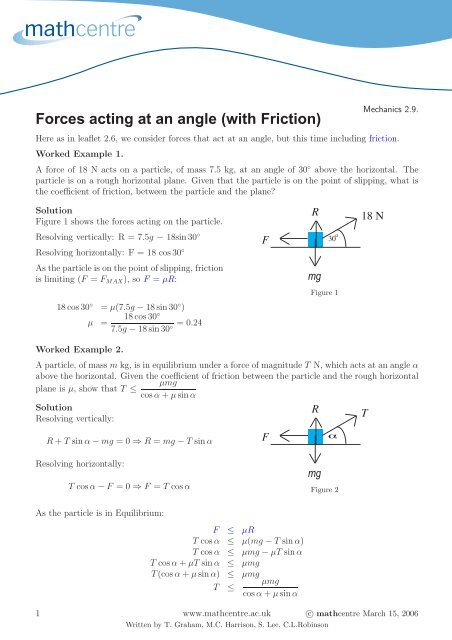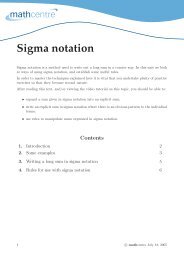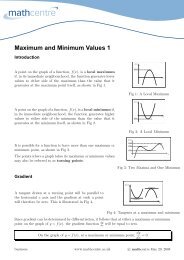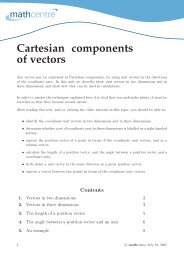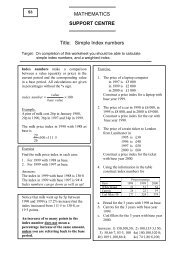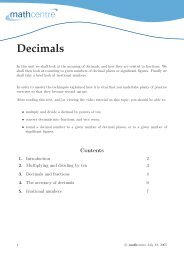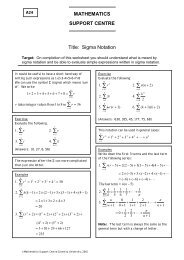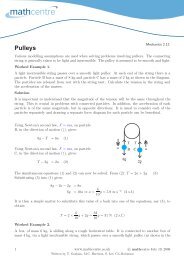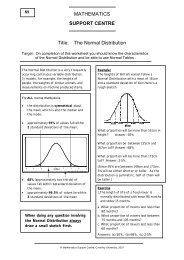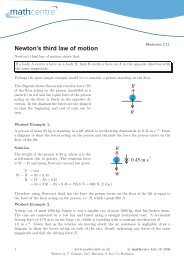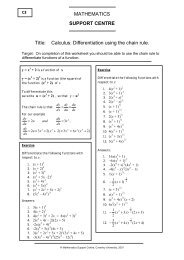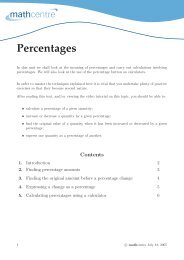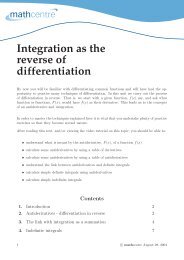Forces acting at an angle (with Friction)
Forces acting at an angle (with Friction)
Forces acting at an angle (with Friction)
You also want an ePaper? Increase the reach of your titles
YUMPU automatically turns print PDFs into web optimized ePapers that Google loves.
<strong>Forces</strong> <strong>acting</strong> <strong>at</strong> <strong>an</strong> <strong>an</strong>gle (<strong>with</strong> <strong>Friction</strong>)<br />
Mech<strong>an</strong>ics 2.9.<br />
Here as in leaflet 2.6, we consider forces th<strong>at</strong> act <strong>at</strong> <strong>an</strong> <strong>an</strong>gle, but this time including friction.<br />
Worked Example 1.<br />
A force of 18 N acts on a particle, of mass 7.5 kg, <strong>at</strong> <strong>an</strong> <strong>an</strong>gle of 30 ◦ above the horizontal. The<br />
particle is on a rough horizontal pl<strong>an</strong>e. Given th<strong>at</strong> the particle is on the point of slipping, wh<strong>at</strong> is<br />
the coefficient of friction, between the particle <strong>an</strong>d the pl<strong>an</strong>e?<br />
Solution<br />
Figure 1 shows the forces <strong>acting</strong> on the particle.<br />
Resolving vertically: R = 7.5g − 18sin 30 ◦<br />
Resolving horizontally: F = 18 cos 30 ◦<br />
As the particle is on the point of slipping, friction<br />
is limiting (F = F MAX ), so F = µR:<br />
18 cos 30 ◦ = µ(7.5g − 18 sin30 ◦ )<br />
µ =<br />
mg<br />
18 cos 30 ◦<br />
7.5g − 18 sin30 = 0.24 ◦<br />
F<br />
R<br />
o<br />
30<br />
Figure 1<br />
18 N<br />
Worked Example 2.<br />
A particle, of mass m kg, is in equilibrium under a force of magnitude T N, which acts <strong>at</strong> <strong>an</strong> <strong>an</strong>gle α<br />
above the horizontal. Given the coefficient of friction between the particle <strong>an</strong>d the rough horizontal<br />
µmg<br />
pl<strong>an</strong>e is µ, show th<strong>at</strong> T ≤<br />
cosα + µ sin α<br />
Solution<br />
R T<br />
Resolving vertically:<br />
R + T sin α − mg = 0 ⇒ R = mg − T sin α<br />
F<br />
α<br />
Resolving horizontally:<br />
T cosα − F = 0 ⇒ F = T cosα<br />
mg<br />
Figure 2<br />
As the particle is in Equilibrium:<br />
F ≤ µR<br />
T cos α ≤ µ(mg − T sin α)<br />
T cos α ≤ µmg − µT sin α<br />
T cosα + µT sin α ≤ µmg<br />
T(cosα + µ sin α) ≤ µmg<br />
µmg<br />
T ≤<br />
cosα + µ sinα<br />
1 www.m<strong>at</strong>hcentre.ac.uk c○ m<strong>at</strong>hcentre March 15, 2006<br />
Written by T. Graham, M.C. Harrison, S. Lee, C.L.Robinson
Worked Example 3.<br />
A light inextensible rope is used to pull a particle of mass 2.5 kg along a rough horizontal pl<strong>an</strong>e. If<br />
the tension in the rope is 25 N <strong>an</strong>d acts <strong>at</strong> <strong>an</strong> <strong>an</strong>gle of 25 ◦ above the horizontal <strong>an</strong>d the coefficient of<br />
sliding friction between the particle <strong>an</strong>d the surface is 0.55, wh<strong>at</strong> is the acceler<strong>at</strong>ion of the particle?<br />
Solution<br />
As the motion is horizontal, the sum of vertical<br />
components of the force equals zero.<br />
Resolving vertically: R = 2.5g − 25 sin25 ◦<br />
As the particle is moving the frictional force<br />
s<strong>at</strong>isfies F = µR, where µ is the coefficient of<br />
sliding friction:<br />
F = µR = 0.55(2.5g − 25 sin25 ◦ )<br />
The result<strong>an</strong>t force is 25cos 25 ◦ − F.<br />
Use Newton’s Second Law parallel to the pl<strong>an</strong>e:<br />
ma = 25 cos25 ◦ − 0.55(2.5g − 25 sin 25 ◦ )<br />
a = 25 cos25◦ − 0.55(2.5g − 25 sin 25 ◦ )<br />
= 6.0 m s −2 (2 s.f.)<br />
2.5<br />
Exercises<br />
F<br />
R<br />
mg<br />
o<br />
25<br />
Figure 3<br />
25 N<br />
1. A force of 16 N acts on a particle, of mass 11 kg, <strong>at</strong> <strong>an</strong> <strong>an</strong>gle of 18 ◦ above the horizontal. The<br />
particle is on a rough horizontal pl<strong>an</strong>e. Given the particle is on the point of slipping, wh<strong>at</strong> is<br />
the coefficient of friction, between the particle <strong>an</strong>d the pl<strong>an</strong>e?<br />
2. A particle, of mass 6 kg, is in equilibrium on a rough horizontal pl<strong>an</strong>e under a force of<br />
magnitude T N, which acts <strong>at</strong> <strong>an</strong> <strong>an</strong>gle 15 ◦ above the horizontal. Given the coefficient of<br />
friction between the particle <strong>an</strong>d the rough horizontal pl<strong>an</strong>e is 0.35, wh<strong>at</strong> values could T<br />
take?<br />
3. A light inextensible rope is used to pull a particle of mass 3 kg along a rough horizontal<br />
pl<strong>an</strong>e. The tension in the rope is 15 N <strong>an</strong>d acts <strong>at</strong> <strong>an</strong> <strong>an</strong>gle of 40 ◦ above the horizontal.<br />
If the coefficient of sliding friction between the particle <strong>an</strong>d the surface is 0.45, wh<strong>at</strong> is the<br />
acceler<strong>at</strong>ion of the particle?<br />
4. A force of 48 N acts on a particle on a rough horizontal pl<strong>an</strong>e <strong>at</strong> <strong>an</strong> <strong>an</strong>gle of 20 ◦ above the<br />
horizontal. Given the particle is on the point of slipping, <strong>an</strong>d the coefficient of friction between<br />
the particle <strong>an</strong>d the pl<strong>an</strong>e is 0.6, wh<strong>at</strong> is the mass of the particle?<br />
5. The coefficient of friction between a particle, of mass 8.5 kg, <strong>an</strong>d a rough horizontal pl<strong>an</strong>e is<br />
0.8. Given a force of 50 N acts on the particle <strong>at</strong> <strong>an</strong> <strong>an</strong>gle of 40 ◦ above the horizontal, does<br />
slipping occur?<br />
6. A light inextensible rope is used to pull a particle of mass 2 kg along a rough horizontal pl<strong>an</strong>e.<br />
Given the tension in the rope is 27 N <strong>an</strong>d acts <strong>at</strong> <strong>an</strong> <strong>an</strong>gle of 30 ◦ above the horizontal <strong>an</strong>d<br />
th<strong>at</strong> the particle is moving <strong>with</strong> <strong>an</strong> acceler<strong>at</strong>ion of 10 m s −2 , wh<strong>at</strong> is the coefficient of sliding<br />
friction between the particle <strong>an</strong>d the surface?<br />
Answers (all to 2 s.f.)<br />
1. 0.15 2. T ≤ 19 N 3. 0.86 m s −2 4. 9.3 kg 5. No, F = 38 N< 41 N (F MAX ) 6. 0.55<br />
2 www.m<strong>at</strong>hcentre.ac.uk c○ m<strong>at</strong>hcentre March 15, 2006<br />
Written by T. Graham, M.C. Harrison, S. Lee, C.L.Robinson


